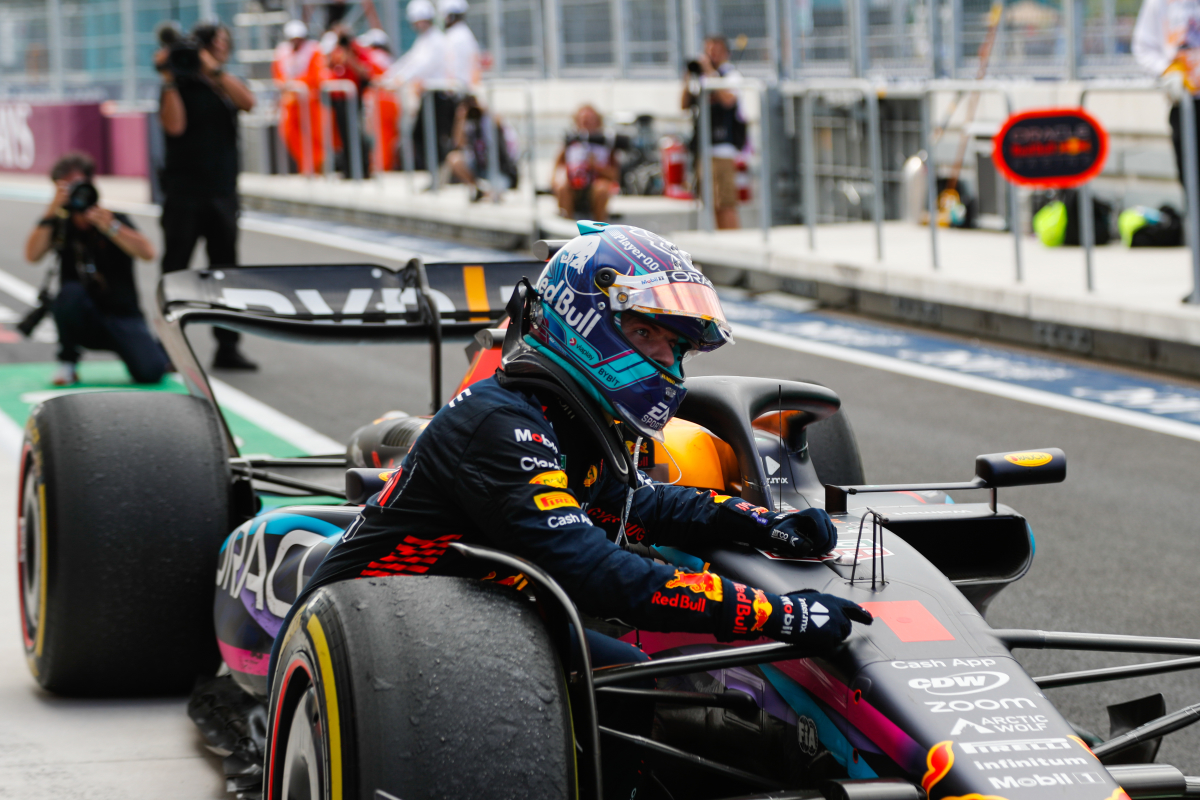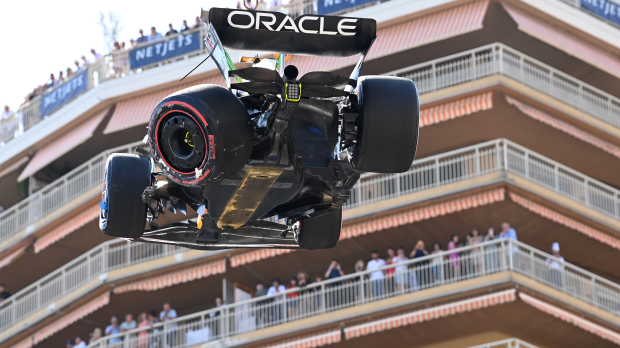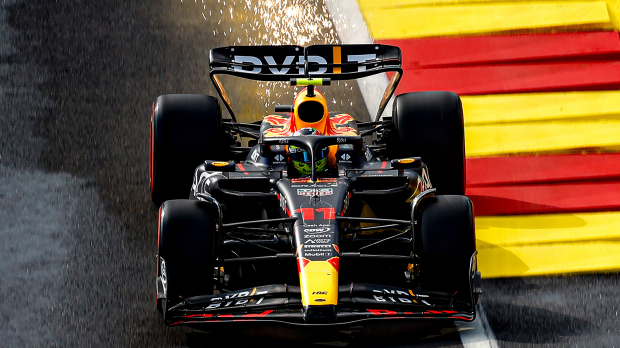
The unlikely feature that EVERY F1 car on the grid has
The unlikely feature that EVERY F1 car on the grid has

After Sergio Perez crashed his RB19 during qualifying for the Monaco Grand Prix, Red Bull were furious in the aftermath.
Not at the Mexican’s ability to keep the car on track – although the jury is out on their true feelings with his performance compared to Max Verstappen this season – but rather at the removal of their rocketship.
Despite being the most dominant car on track, there was a great deal of intrigue and mystery surrounding what exactly made Adrian Newey’s brainchild so powerful.
So when Perez’s RB19 was attached to a crane and hoisted high into the air, all eyes were on one thing – the floor.
The previously secret undercarriage was exposed for all to see and the thousands of hours dedicated to its creation now hung out as if it were simply washing on a line.
READ MORE: Verstappen open to ditching Red Bull in SENSATIONAL move to F1 rival
Mercedes, Ferrari and the rest of Red Bull’s F1 rivals quickly got to work no doubt to see what they could ascertain from its intricate design.
Yet for a section of F1 fans, something far more intriguing stood out.
F1's curious feature

Running through the middle of the RB19’s floor was something so at odds with the peaks, troughs and curvature of its floor – a plank of wood.
To many, this came as no surprise. Yet for those somewhat newer to the sport, perhaps caught up in the wave of Netflix’s Drive to Survive, the inclusion of something so barbarically simplistic on such a complex design was an incredibly jarring principle.
Thoughts then turned to the shower of sparks that are seen coming from the back of an F1 car and the use of wood became even more bizarre.
Yet the fact of the matter is, that plank of wood is a key reason as to why the sparks fly behind the cars.
Made out of a wood material called Jabroc, the plank is known as a skid block. Jabroc is traditionally made of beechwood, with veneers and resin used in each layer as it is built in a composite process.
Mandated in the sport since 1994, following the accident that led to Ayrton Senna’s tragic death at Imola, the planks fitted underneath every car demonstrate how close it is running to the ground by the amount of wear shown on the wood.
When new, the Jabroc must be uniformly 10mm thick, with a 0.2mm margin of error permitted. The thickness of this plank is one of the parc ferme tests carried out following qualifying and race sessions.
If the plank shows wear of more than 1mm, the driver of that car will be disqualified.
Michael Schumacher was caught out with this very issue after the 1994 Belgian Grand Prix, back when he was driving in a Benetton. The F1 great crossed the line in first, but lost his race win due to excessive wear on his skid block.
But what about the sparks?

A plume of sparks flying out the back of an F1 car becomes that much more unnerving when you know there is a plank of wood underneath it.
Yet the sparks are not caused by the wood itself, rather a few carefully positioned pieces of titanium.
To avoid the skid block being worn out excessively, teams strategically place titanium skid blocks of no more than 3mm in depth that serve to protect the wooden plank.
And when travelling at higher speeds, the downforce increases and pushes the car closer to the track. This is why the sparks are more noticeable on the straight, especially at the start of a race when up to 110kg of fuel is also on board.
The sparks that fly is therefore a sign that things are working as planned, with the titanium skid blocks making contact with the floor, rather than the wood.
Although each F1 team spends countless hours looking to eke out fractions of a second worth of an advantage compared to their rivals – the uniformity of the wooden plank will remain the same for each competitor.
Therefore the next time you see an F1 car hoisted into the air by a crane at a race weekend, be it Lewis Hamilton, Logan Sargeant or Fernando Alonso, don’t be surprised to see that very same plank of wood on display.
READ MORE: F1 aero expert explains Ricciardo improvement as MULTIPLE teams eye him up
Related
Change your timezone:
Latest News

Red Bull announce strong statement over Newey departure claims
- 38 minutes ago

Verstappen 'to meet Mercedes over SHOCK 2025 move as Red Bull exit clause revealed'
- 1 hour ago

F1 champion reveals £100 MILLION contract to keep racing
- 2 hours ago

F1 News Today: Newey 'property hunt' reveals Red Bull exit clues as Hamilton hints at Ferrari swoop
- 3 hours ago

Sky Sports F1 pundit calls for RADICAL change with impressive argument
- 3 hours ago
- 1

Newey TURNED DOWN F1 rivals before Red Bull decision
- Today 15:56
Related news

F1 decision announced regarding points system change

F1 boss HITS BACK at star driver over schedule complaints

F1 franchise welcomes return of INCREDIBLE feature

F1 legend issues DAMNING verdict on proposed rule change
F1 Standings

Drivers
- Oliver Bearman
- Charles Leclerc
- Carlos Sainz
- Lando Norris
- Oscar Piastri
- Pierre Gasly
- Esteban Ocon
- Sergio Pérez
- Max Verstappen
- Alexander Albon
- Logan Sargeant
- Lewis Hamilton
- George Russell
- Nico Hülkenberg
- Kevin Magnussen
- Fernando Alonso
- Lance Stroll
- Valtteri Bottas
- Zhou Guanyu
- Daniel Ricciardo
- Yuki Tsunoda
Races
-
 Gulf Air Grand Prix of Bahrain 2024
Gulf Air Grand Prix of Bahrain 2024
-
 Saudi Arabian Grand Prix 2024
Saudi Arabian Grand Prix 2024
-
 Grand Prix of Australia 2024
Grand Prix of Australia 2024
-
 MSC Cruises Grand Prix of Japan 2024
MSC Cruises Grand Prix of Japan 2024
-
 Grand Prix of China 2024
Grand Prix of China 2024
-
 Miami Grand Prix 2024
Miami Grand Prix 2024
-
 Gran Premio dell'Emilia Romagna 2024
Gran Premio dell'Emilia Romagna 2024
-
 Grand Prix of Monaco 2024
Grand Prix of Monaco 2024
-
 Grand Prix du Canada 2024
Grand Prix du Canada 2024
-
 Gran Premio de España 2024
Gran Premio de España 2024
-
 Grand Prix of Austria 2024
Grand Prix of Austria 2024
-
 Grand Prix of Great Britain 2024
Grand Prix of Great Britain 2024
-
 Grand Prix of Hungary 2024
Grand Prix of Hungary 2024
-
 Grand Prix of Belgium 2024
Grand Prix of Belgium 2024
-
 Heineken Dutch Grand Prix 2024
Heineken Dutch Grand Prix 2024
-
 Grand Prix of Italy 2024
Grand Prix of Italy 2024
-
 Grand Prix of Azerbaijan 2024
Grand Prix of Azerbaijan 2024
-
 Grand Prix of Singapore 2024
Grand Prix of Singapore 2024
-
 Grand Prix of the United States 2024
Grand Prix of the United States 2024
-
 Gran Premio de la Ciudad de Mexico 2024
Gran Premio de la Ciudad de Mexico 2024
-
 Grande Prêmio de São Paulo 2024
Grande Prêmio de São Paulo 2024
-
 Heineken Silver Las Vegas Grand Prix 2024
Heineken Silver Las Vegas Grand Prix 2024
-
 Qatar Grand Prix 2024
Qatar Grand Prix 2024
-
 Grand Prix of Abu Dhabi 2024
Grand Prix of Abu Dhabi 2024
About GPFans
GPFans is a multi-platform, multi-language brand dedicated to Formula One coverage. We bring you all the ins and outs of the sport, 24/7, everything from up-to-the-minute news and features to the latest viral stories and clips.We believe that a new generation of exciting, outspoken drivers will make F1 more popular than ever before, and we want to give our users access to as much of their heroes as possible, on and off the track. From Lewis Hamilton to Max Verstappen, Daniel Ricciardo to Sebastian Vettel, we provide in-depth analysis of every every Grand Prix in the season, from Australia to Abu Dhabi.
With Formula One under the new ownership of Liberty Media, how the sport is being covered is evolving, and GPFans will look to be at the heart of this progression into new media, as one of the fastest-growing sites covering the king of motorsports.
Follow us on your favorite social media channel
Corporate & Media
 Innovatieweg 20C
Innovatieweg 20C7007 CD, Doetinchem, Netherlands
+31645516860



















 Gulf Air Grand Prix of Bahrain 2024
Gulf Air Grand Prix of Bahrain 2024  Saudi Arabian Grand Prix 2024
Saudi Arabian Grand Prix 2024  Grand Prix of Australia 2024
Grand Prix of Australia 2024  MSC Cruises Grand Prix of Japan 2024
MSC Cruises Grand Prix of Japan 2024  Grand Prix of China 2024
Grand Prix of China 2024  Gran Premio dell'Emilia Romagna 2024
Gran Premio dell'Emilia Romagna 2024  Grand Prix of Monaco 2024
Grand Prix of Monaco 2024  Grand Prix du Canada 2024
Grand Prix du Canada 2024  Gran Premio de España 2024
Gran Premio de España 2024  Grand Prix of Austria 2024
Grand Prix of Austria 2024  Grand Prix of Hungary 2024
Grand Prix of Hungary 2024  Grand Prix of Belgium 2024
Grand Prix of Belgium 2024  Grand Prix of Azerbaijan 2024
Grand Prix of Azerbaijan 2024  Grand Prix of Singapore 2024
Grand Prix of Singapore 2024  Gran Premio de la Ciudad de Mexico 2024
Gran Premio de la Ciudad de Mexico 2024  Grande Prêmio de São Paulo 2024
Grande Prêmio de São Paulo 2024  Qatar Grand Prix 2024
Qatar Grand Prix 2024  Grand Prix of Abu Dhabi 2024
Grand Prix of Abu Dhabi 2024